Threats
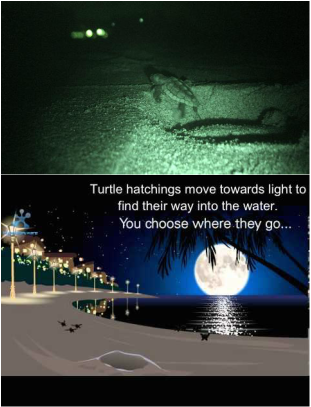 Light pollution has profound negative impact on survival of hatchlings. Sea turtle babies follow the artificial lights and miss the sea, going to die on the following day.
Light pollution has profound negative impact on survival of hatchlings. Sea turtle babies follow the artificial lights and miss the sea, going to die on the following day.
Habitat Loss and Degradation
Coastal development has directly led to the destruction of turtle nesting beaches. Artificial beachfront lights from roads, buildings, vehicles and other sources threatens newly hatched sea turtles because hatchlings are easily attracted by lights and artificial lights lure them away from the sea. Disoriented hatchlings can be trapped by vegetation or beach debris. The results of disorientation are often fatal because as hatchlings head toward lights, their exposure to predators and the likelihood of dehydration are greatly increased. In Florida, many hatchlings are frequently found dead on nearby roadways and in parking lots after being struck by vehicles (Conservation Plan for Hawksbill Turtle, 1993). Not only artificial lights, other remarkable achievements of coastal development such as sea walls and jetties, traffic and seaside buildings also threaten sea turtles. These constructions change long-shore drift patterns and thus cause erosion of the sand or destruction of entire sections of beach, making it nearly impossible for female turtles to dig nests and hatchlings to return back to the sea (WWF). Hawksbills around shallow healthy coral reefs and help maintain the health of coral reefs by removing prey such as sponges from the reef's surface. However, coral reefs are now among the world's most endangered marine ecosystems. Climate change and pollution have led to massive coral bleaching events, bring permanent damage to local habitats and causing the Hawksbills population to decline as a consequence (Wild Conservation Society) .
Coastal development has directly led to the destruction of turtle nesting beaches. Artificial beachfront lights from roads, buildings, vehicles and other sources threatens newly hatched sea turtles because hatchlings are easily attracted by lights and artificial lights lure them away from the sea. Disoriented hatchlings can be trapped by vegetation or beach debris. The results of disorientation are often fatal because as hatchlings head toward lights, their exposure to predators and the likelihood of dehydration are greatly increased. In Florida, many hatchlings are frequently found dead on nearby roadways and in parking lots after being struck by vehicles (Conservation Plan for Hawksbill Turtle, 1993). Not only artificial lights, other remarkable achievements of coastal development such as sea walls and jetties, traffic and seaside buildings also threaten sea turtles. These constructions change long-shore drift patterns and thus cause erosion of the sand or destruction of entire sections of beach, making it nearly impossible for female turtles to dig nests and hatchlings to return back to the sea (WWF). Hawksbills around shallow healthy coral reefs and help maintain the health of coral reefs by removing prey such as sponges from the reef's surface. However, coral reefs are now among the world's most endangered marine ecosystems. Climate change and pollution have led to massive coral bleaching events, bring permanent damage to local habitats and causing the Hawksbills population to decline as a consequence (Wild Conservation Society) .
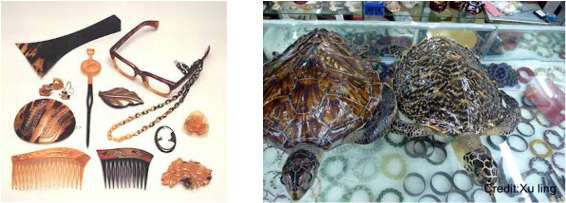 Left: Traditional Japanese tortoiseshell work.
Right: illegal sale of marine turtles in Hainan, China. (photo: Xu Ling/TRAFFIC)
Left: Traditional Japanese tortoiseshell work.
Right: illegal sale of marine turtles in Hainan, China. (photo: Xu Ling/TRAFFIC)
Wildlife Trade
- Shells
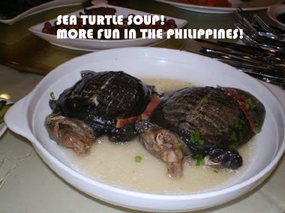 Sea turtle soup loved by Filipinos.
Sea turtle soup loved by Filipinos.
- Eggs and Meat
 In Kalimantan, Indonesia, authorities seized a Chinese boat with 397 sea turtles aboard. All turtles were dead.
(www.turlte-foundation.org)
In Kalimantan, Indonesia, authorities seized a Chinese boat with 397 sea turtles aboard. All turtles were dead.
(www.turlte-foundation.org)
- Case Study
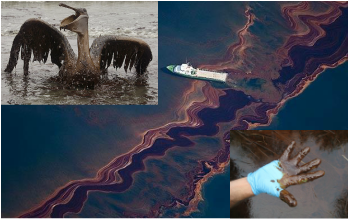 The Impact of Mexico Oil Spill to Species, 2010, NOAA
The Impact of Mexico Oil Spill to Species, 2010, NOAA
Marine Pollution ( Oil Spill and White Plastic Bags )
The Gulf of Mexico is the home to five of the world’s seven sea turtle species: green, loggerhead, hawksbill, leatherback, and kemp’s ridley turtles (Gulf Oil Spill: Effects on Wildlife and Habitats, New England Aquarium). The 2010 Gulf of Mexico Oil Spill is recognized as the worst oil in U.S. history because it is totally a wildlife disaster (The Oil Portal Team, 2010). In total, researchers found that the oil spill has likely harmed or killed approximately 82,000 birds of 102 species, 6,165 sea turtles, up to 25,900 marine mammals, including dolphins and whales, and unknown number of fishes, crabs, oysters, corals and many other sea life (NOAA & A Deadly Toll, 2011, Center for Biological Diversity).
- Gulf of Mexico Oil Spill, 2010
The Gulf of Mexico is the home to five of the world’s seven sea turtle species: green, loggerhead, hawksbill, leatherback, and kemp’s ridley turtles (Gulf Oil Spill: Effects on Wildlife and Habitats, New England Aquarium). The 2010 Gulf of Mexico Oil Spill is recognized as the worst oil in U.S. history because it is totally a wildlife disaster (The Oil Portal Team, 2010). In total, researchers found that the oil spill has likely harmed or killed approximately 82,000 birds of 102 species, 6,165 sea turtles, up to 25,900 marine mammals, including dolphins and whales, and unknown number of fishes, crabs, oysters, corals and many other sea life (NOAA & A Deadly Toll, 2011, Center for Biological Diversity).
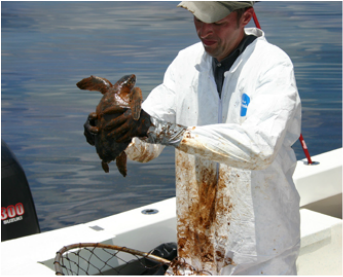 2010 Gulf of Mexico Oil Spill: Sea Turtles, Dolphins, and Whales/NOAA,
2010 Gulf of Mexico Oil Spill: Sea Turtles, Dolphins, and Whales/NOAA,
Studies have noted that sea turtles do not instinctively avoid oil slicks, putting them at greater risk for exposure when they surface for air (Oil Spill Impacts on Sea Turtles,National Wildlife Federation).When sea turtles swim in oil-covered water, they can breathe in the oil vapors and residues, which can get into their lungs and cause major respiratory problems. Oil can also get into the their eyes,potentially causing damage to vision. If oil gets into sea turtles' mouths and they ingest it, it can potentially damage their internal organs. Oil also threatens sea turtle hatchlings. If the eggs are covered with oil, hatchlings would undergo an more intense struggle in order to break through the leathery eggshell and fail to break through the eggshell would cause them to die inside the eggshell, just before the journey begins.
Some major effects includes:
Some major effects includes:
- Burning in mucous membranes of the eyes and mouth
- Irritation or inflammation of the skin
- Gastrointestinal inflammation, ulcers, bleeding, poor digestion
- Respiratory irritation, inflammation, pneumonia, emphysema
- Organ damage, suppression of the immune system, reproductive failure
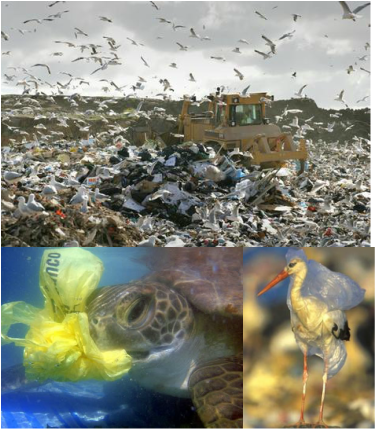 Approximately a trilion (1,000,000,000,000) of plastic bags are produced each year and over a hunderd million (100,000,000) marine animals are dead every year because of plastic bags. www.occupyforanimals.net
Approximately a trilion (1,000,000,000,000) of plastic bags are produced each year and over a hunderd million (100,000,000) marine animals are dead every year because of plastic bags. www.occupyforanimals.net
White Plastic Pollution
A few facts about plastic bags:
A few facts about plastic bags:
- Each year, approximately 500 billion to 1 trillion plastic bags are consumed worldwide. That's over one million bags per minute. Billions of them end up as litter each year. But, less than 1% of bags are recycled. It costs more to recycle a bag than to produce a new one
- 60,000 plastic bags are being used in the U.S. every five seconds.
- Plastic bags are made of polyethylene, a petroleum product. The Worldwatch Institute estimates that in the U.S. alone, an estimated 12,000,000 barrels of non-renewable petroleum oil are required to produce the 100 billion bags consumed annually. That's over $500,000,000 the country could be saving to put towards clean, green energy. The petroleum used to make only 14 plastic bags could drive a car 1 mile.
- Over 100 million marine animals, including highly intelligent, adorable sea turtles, whales and dolphins, die every year due to plastic debris in the ocean.
- In some parts of the ocean there are 6 pounds of plastic for every pound of plankton.
- Plastic never goes away. It fragments into millions of tiny toxic pieces that are ingested by wildlife. They can take from 400 to 1,000 years to decompose but their chemicals residues remain for years after that.
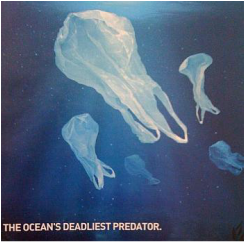 You see the difference, a turtle does not.
You see the difference, a turtle does not.
It's much more easier for plastic bags to enter the ocean than we think and there are many ways for them to get to the ocean. They can be washed out from the streets and beaches, travels through storm drains into streams and rivers or flies away from landfills into the sea. Because sea turtles cannot distinguish between floating jellyfish, a main component of their diet, and floating translucent plastic bags, thousands of sea turtles accidentally swallow these indigestible plastic bags as food. These nonnutritive plastic bags will wrap around their intestines and make them feel full. Ultimately they will die of disease like intestinal hemorrhage,intestinal cancer, malnutrition or toxic chemical remnants (Threats to sea turtles,Sea Turtle Conservancy) .
Balazs (1985) first to examine the widespread effects and impacts of marine debris on sea turtles. He summarized published cases of the ingestion of debris by Hawksbills and reported that 88.9 % of the articles covered plastic bags, plastic and Styrofoam particles, and tar. Among all sea turtles investigated, 69% of immature turtles ingested debris, whereas 31% of adult turtles ingested debris (Qamar Schuyler, 2012).Carr and Stancyk (1975) reported many plastic and man-made litters were found in the stomachs of Hawksbills from Costa Rica.
Balazs (1985) first to examine the widespread effects and impacts of marine debris on sea turtles. He summarized published cases of the ingestion of debris by Hawksbills and reported that 88.9 % of the articles covered plastic bags, plastic and Styrofoam particles, and tar. Among all sea turtles investigated, 69% of immature turtles ingested debris, whereas 31% of adult turtles ingested debris (Qamar Schuyler, 2012).Carr and Stancyk (1975) reported many plastic and man-made litters were found in the stomachs of Hawksbills from Costa Rica.
|
The video below shows the consequence for sea turtles after BP Oil Spill.
|
The video below shows what happened to sea turtles after eating plastic bags.
|
